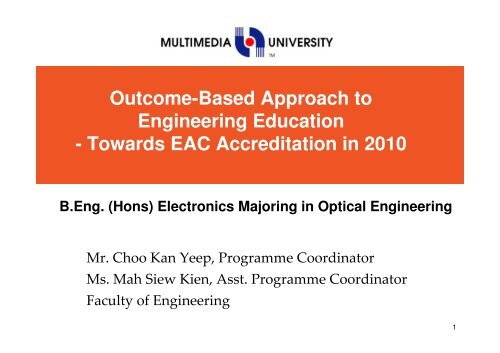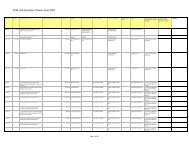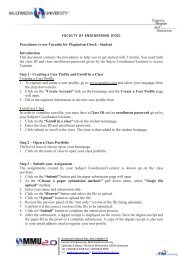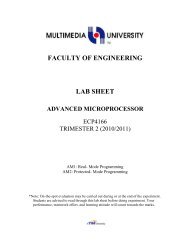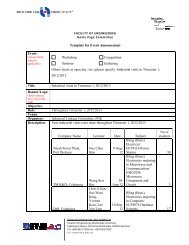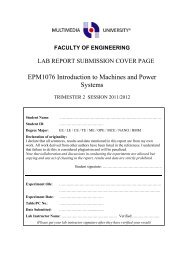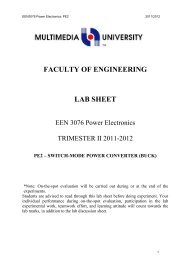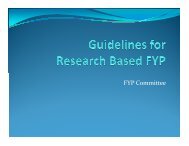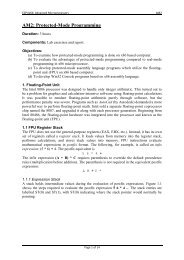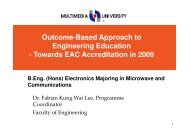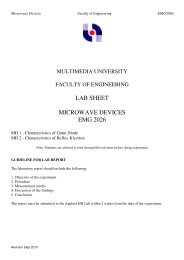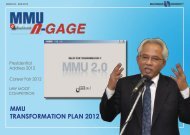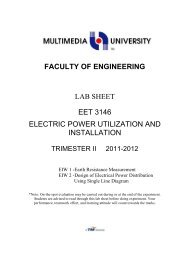Outcome-Based Approach to Engineering Education - Faculty of ...
Outcome-Based Approach to Engineering Education - Faculty of ...
Outcome-Based Approach to Engineering Education - Faculty of ...
Create successful ePaper yourself
Turn your PDF publications into a flip-book with our unique Google optimized e-Paper software.
<strong>Outcome</strong>-<strong>Based</strong> <strong>Approach</strong> <strong>to</strong><br />
<strong>Engineering</strong> <strong>Education</strong><br />
- Towards EAC Accreditation in 2010<br />
B.Eng. (Hons) Electronics Majoring in Optical <strong>Engineering</strong><br />
Mr. Choo Kan Yeep, Programme Coordina<strong>to</strong>r<br />
Ms. Mah Siew Kien, Asst. Programme Coordina<strong>to</strong>r<br />
<strong>Faculty</strong> <strong>of</strong> <strong>Engineering</strong><br />
1
Why This Briefing?<br />
• FOE has been practicing <strong>Outcome</strong>-<strong>Based</strong> <strong>Education</strong><br />
(OBE) approach since 2006.<br />
• The B.Eng. (Hons) Electronics Majoring in Optical<br />
<strong>Engineering</strong> Program will be assessed by a team from<br />
<strong>Engineering</strong> Accreditation Council (EAC) around<br />
This means <strong>to</strong> <strong>to</strong> perform quality control and decide<br />
June/July 2010.<br />
whether or or not <strong>to</strong> <strong>to</strong> recognise the programmes<br />
• EAC is the cus<strong>to</strong>dian <strong>of</strong> OBE practices for engineering<br />
degrees and accredits engineering programmes at<br />
institutes <strong>of</strong> higher learning in Malaysia.<br />
• Students will be randomly selected by EAC for<br />
interview, <strong>to</strong> obtain feedback about the program.<br />
2
What Is <strong>Outcome</strong> <strong>Based</strong> <strong>Engineering</strong> <strong>Education</strong>?<br />
IT’S NOT WHAT WE TEACH,<br />
IT’S WHAT YOU LEARN<br />
In a nutshell, learner-centric approach<br />
<strong>to</strong> tertiary education<br />
3
Contents<br />
• What is EAC?<br />
• Why Need Accreditation?<br />
• EAC Accreditation Criteria<br />
• Deficiencies <strong>of</strong> Traditional <strong>Education</strong><br />
• <strong>Outcome</strong> <strong>Based</strong> <strong>Education</strong> (OBE)<br />
• Roles <strong>of</strong> Lecturers<br />
• Roles <strong>of</strong> Students<br />
• Q & A<br />
4
What Is EAC?<br />
• Formed in 2000, a delegated body from Board <strong>of</strong><br />
Engineers Malaysia (BEM), the only body for<br />
accrediting engineering degree programs.<br />
• Comprises members from BEM, IEM, PSD, MQA and<br />
Industry Representatives.<br />
IEM (Institution<br />
<strong>of</strong> Engineers,<br />
Malaysia)<br />
EAC<br />
Useful links:<br />
EAC: www.eac.org.my<br />
BEM: www.bem.org.my<br />
MQA: www.lan.govm.my<br />
BEM<br />
(Board <strong>of</strong> Engineers<br />
Malaysia)<br />
PSD (Public Service Dept.)<br />
MQA (Agensi Kelayakan Malaysia)
Roles <strong>of</strong> EAC<br />
<strong>Engineering</strong> Accreditation Council<br />
• Formulates and updates accreditation policies and criteria.<br />
• Approves guidelines and operating procedures.<br />
• Oversees operational arrangements and appoints<br />
evaluation panel.<br />
• Receives evaluation reports and decides on accreditation.<br />
• Responds <strong>to</strong> complaints, appeals or any proposals for<br />
change.<br />
• Oversees development and operation <strong>of</strong> accreditation and<br />
mutual recognition agreement with other countries.<br />
• Fosters the dissemination <strong>of</strong> developments and best<br />
practices in engineering education.<br />
6
Why Need Accreditation?<br />
Recognition by Malaysian Government,<br />
under REGISTRATION OF ENGINEERS<br />
ACT 1967 (Revised 2002)<br />
• An accredited engineering degree means the degree is<br />
recognized by the Malaysian government.<br />
• It is also a sign <strong>of</strong> the degree being <strong>of</strong> high quality and the<br />
holder <strong>of</strong> the degree has already attained a certain level<br />
<strong>of</strong> knowledge, skill and maturity <strong>of</strong> thought related <strong>to</strong> the<br />
relevant discipline.<br />
• A person with accredited engineering degree may be<br />
able <strong>to</strong> work for the government, as well as private sec<strong>to</strong>r.<br />
• He/she may subsequently become a Pr<strong>of</strong>essional<br />
Engineer.<br />
7
Why Need Accreditation?<br />
• Legally, no person is allowed <strong>to</strong> practice unless he/she is<br />
a pr<strong>of</strong>essional engineer.<br />
• Pr<strong>of</strong>essional engineer may use “Ir” before his name OR<br />
“PEng” after his name.<br />
• Graduate engineers <strong>to</strong> register with BEM before taking<br />
up employment as an engineer.<br />
8
Why Need Accreditation?<br />
• graduate engineers <strong>to</strong> register before taking<br />
up employment as an engineer.<br />
Those who has successfully completed an<br />
accredited (recognized) engineering programme<br />
Pr<strong>of</strong>essional Engineer - a graduate engineer who has<br />
obtained the prescribed practical experience, passed the<br />
Pr<strong>of</strong>essional Assessment Examination, and satisfied all other<br />
requirements <strong>of</strong> the Board <strong>of</strong> Engineers (BEM)<br />
9
Why Need Accreditation?<br />
International Mobility (Washing<strong>to</strong>n Accord)<br />
• The Washing<strong>to</strong>n Accord (WA): Agreement that<br />
establishes equivalence <strong>of</strong> other countries’ accredited<br />
pr<strong>of</strong>essional engineering programs.<br />
• Accredited <strong>Engineering</strong> Graduates are recognized by<br />
other signa<strong>to</strong>ry countries - Possible employment as<br />
engineers in those countries without further<br />
examinations.<br />
10
Why Need Accreditation?<br />
International Mobility (Washing<strong>to</strong>n Accord)<br />
• Established in 1989, as <strong>of</strong> 2007, the following countries<br />
are full members <strong>of</strong> WA: Australia, Canada, the<br />
Republic <strong>of</strong> Ireland, Hong Kong, Japan, New Zealand,<br />
Singapore, South Africa, South Korea, Taiwan, the UK<br />
and the USA.<br />
• The following countries are provisional members <strong>of</strong> the<br />
WA and may become a full member in the future:<br />
Germany, India, Russia, and Sri Lanka.<br />
• Malaysia was provisional member since 2003 and now<br />
become full member in 2009.<br />
11
Why Need Accreditation?<br />
Our last accreditation was in 2006 for 5-year programme.<br />
Next accreditation visit will be in June/July 2010<br />
- for intakes <strong>of</strong> 2006 & onwards<br />
Our programme has been accredited before,<br />
so what’s the big deal?<br />
Programmes <strong>to</strong> be accredited in 2010 will<br />
have <strong>to</strong> be based on OBE approach!<br />
NO OBE = NO ACCREDITATION<br />
12
EAC Accreditation Criteria<br />
Academic Curriculum<br />
Students<br />
Academic and Supporting Staff<br />
Facilities<br />
Quality Management System<br />
13
EAC Accreditation Criteria<br />
• Academic Staff<br />
Academic qualifications<br />
Pr<strong>of</strong>essional qualification, experience &<br />
development<br />
Research/publication/consultancy<br />
Industrial involvement<br />
Teaching load/contact hours<br />
Motivation and enthusiasm<br />
Use <strong>of</strong> lecturers from industry/public bodies<br />
Aware and practice <strong>of</strong> OBE<br />
14
<strong>Outcome</strong>-<strong>Based</strong> <strong>Education</strong> (OBE)<br />
• OBE is an educational process that focuses on what students<br />
can do or the qualities they should develop after they are<br />
taught.<br />
• OBE involves the restructuring <strong>of</strong> curriculum, assessment and<br />
reporting practices in education <strong>to</strong> reflect the achievement <strong>of</strong><br />
high order learning and mastery rather than accumulation <strong>of</strong><br />
course credits.<br />
• Both structures and curricula are designed <strong>to</strong> achieve those<br />
capabilities or qualities.<br />
• Discourages traditional education approaches based on direct<br />
instruction <strong>of</strong> facts and standard methods.<br />
• It requires that the students demonstrate that they have learnt<br />
the required skills and content.<br />
15
Why OBE - Deficiencies <strong>of</strong> Traditional<br />
<strong>Education</strong><br />
Provides students with a learning environment with little<br />
attention <strong>to</strong> whether or not students ever learn the<br />
material.<br />
Students are given grades and rankings compared <strong>to</strong><br />
each other – students become exam oriented or CGPA<br />
driven.<br />
Graduates are not completely prepared for the<br />
workforce.<br />
Lack <strong>of</strong> emphasis on s<strong>of</strong>t skills needed in jobs e.g.<br />
communication skills, interpersonal skills, analytical<br />
skills, working attitude etc.<br />
16
Why OBE - Exam Result is Not the<br />
Most Important Consideration by Employer<br />
Employers Rating <strong>of</strong> Skills/Qualities – 2002<br />
• Communication (verbal & written) 4.69<br />
• Honesty/Integrity 4.59<br />
• Teamwork skills 4.54<br />
• Interpersonal skills 4.50<br />
• Strong work ethics 4.46<br />
• Motivation & initiative 4.42<br />
• Flexibility/adaptability 4.41<br />
• Analytical skills 4.36<br />
• Computer skills 4.21<br />
• Organisational skills 4.05<br />
• Detail oriented 4.00<br />
• Leadership skills 3.97<br />
• Self confidence 3.95<br />
• Friendly/outgoing personality 3.85<br />
• Well mannered / polite 3.82<br />
• Tactfulness 3.75<br />
• GPA (3.0 or better) 3.68<br />
• Creativity 3.59<br />
• Sense <strong>of</strong> humour 3.25<br />
• Entrepreneurial skills/risk taker 3.23<br />
17
Focus and Benefits <strong>of</strong> OBE<br />
OBE addresses the following key questions:<br />
• What do we want the students <strong>to</strong> have or be able <strong>to</strong> do?<br />
• How can we best help students achieve it?<br />
• How will we know whether they students have achieved it?<br />
• How do we close the loop for further improvement<br />
(Continuous Quality Improvement (CQI))?<br />
Benefits <strong>of</strong> OBE<br />
• More directed & coherent curriculum.<br />
• Graduates will be more “relevant” <strong>to</strong> industry & other<br />
stakeholders (more well rounded graduates).<br />
• Continuous Quality Improvement (CQI) is in place.<br />
18
Expectations on Students under<br />
OBE – the <strong>Outcome</strong>s<br />
• Students are expected <strong>to</strong> be able <strong>to</strong> do more challenging<br />
tasks other than memorize and reproduce what was taught.<br />
• Students should be able <strong>to</strong>: write project proposals,<br />
complete projects, analyze case studies, give case<br />
presentations, show their abilities <strong>to</strong> think, question,<br />
research, and make decisions based on the findings.<br />
• Be more creative, able <strong>to</strong> analyze and synthesize<br />
information.<br />
• Able <strong>to</strong> plan and organize tasks, able <strong>to</strong> work in a team as a<br />
community or in entrepreneurial service teams <strong>to</strong> propose<br />
solutions <strong>to</strong> problems and market their solutions.<br />
19
OBE Versus Traditional <strong>Education</strong> Process<br />
• Traditional education process focuses on the inputs.<br />
Input<br />
Process<br />
•Teaching Staff<br />
•Curriculum<br />
•Labs<br />
•Other Resource<br />
Teaching &<br />
Learning<br />
Students at<br />
Graduation<br />
• Assessment mainly via exam, test, assignments.<br />
• Quality control from teaching evaluation.<br />
20
Input<br />
•Teaching Staff<br />
•Curriculum<br />
•Labs<br />
•Other Resource<br />
<strong>Outcome</strong>-<strong>Based</strong> <strong>Education</strong> Versus<br />
Traditional <strong>Education</strong> Process<br />
• OBE shifts from measuring input and process <strong>to</strong> include<br />
measuring the output (outcome)<br />
Process<br />
Teaching &<br />
Learning<br />
(Short-term)<br />
Program &<br />
Subject<br />
<strong>Outcome</strong>s<br />
Students at<br />
Graduation<br />
(Long-term)<br />
Program<br />
<strong>Education</strong><br />
<strong>Outcome</strong>s<br />
Graduates<br />
<strong>to</strong> Fulfill<br />
Stakeholders’<br />
Satisfaction<br />
• Assessment by exam, test and assignments.<br />
• Assessment <strong>of</strong> teaching staff, lecture material & flow,<br />
results and student ‘capabilities’ (Short & long-term<br />
outcomes), lab interview, exit survey etc.<br />
• More ‘thinking’ projects, with analysis.<br />
• Feedback from industry, alumni and other stakeholders.<br />
• Clear continuous improvement step.<br />
Stakeholders:<br />
EAC<br />
Employers<br />
Industry Advisors<br />
Academic Staff<br />
Public and Parents<br />
Students<br />
Alumni<br />
21
<strong>Outcome</strong>s in OBE<br />
A Model Hierarchy <strong>of</strong> <strong>Outcome</strong>s<br />
Vision and Mission <strong>of</strong> the Institution/<strong>Faculty</strong><br />
Programme <strong>Education</strong>al Objectives (PEO)<br />
Programme <strong>Outcome</strong>s (PO)<br />
Learning <strong>Outcome</strong>s (CO) <strong>of</strong> Subjects<br />
Long-term<br />
<strong>Outcome</strong>s<br />
Short-term<br />
<strong>Outcome</strong>s<br />
Interrelated and<br />
Complement Each Other<br />
22
Vision and Mission <strong>of</strong> MMU<br />
Vision <strong>of</strong> the University<br />
To be a premier university that propagates the generation and<br />
dissemination <strong>of</strong> knowledge in cutting edge technologies<br />
Mission <strong>of</strong> the University<br />
1. To deliver quality academic programmes based on state-<strong>of</strong>-the-art<br />
R&D.<br />
2. To attract and nurture quality minds who will contribute <strong>to</strong>wards the<br />
global knowledge economy<br />
3. To inculcate a strong research culture within a dynamic, efficient<br />
and effective team <strong>of</strong> academic and support staff<br />
4. To be financially self-sustaining via education and the<br />
commercialisation <strong>of</strong> R&D products and services.<br />
23
Vision and Mission <strong>of</strong> FOE<br />
Vision <strong>of</strong> the <strong>Faculty</strong><br />
To be a leading engineering faculty for creation, preservation and<br />
dissemination <strong>of</strong> knowledge, training <strong>of</strong> knowledge workers for<br />
nation building, and providing continuous technical support for the<br />
ICT industry in Malaysia.<br />
Mission <strong>of</strong> the <strong>Faculty</strong><br />
1. To produce multi-skilled graduates who are able <strong>to</strong> spearhead<br />
nation-building in the Information Age.<br />
2. To provide opportunities and resources for academic and<br />
researchers <strong>to</strong> carry out the state-<strong>of</strong>-the-art research and<br />
development work.<br />
3. To support the growth <strong>of</strong> nationwide ICT industry through provision<br />
<strong>of</strong> continuous pr<strong>of</strong>essional development <strong>of</strong> knowledge.<br />
24
Program <strong>Education</strong>al Objectives for B.Eng. (Hons)<br />
Electronics Majoring in Optical <strong>Engineering</strong><br />
Programme <strong>Education</strong>al Objectives (PEO) are long term<br />
goals (5 years or more after graduation) describing<br />
expected achievements <strong>of</strong> graduates in their career.<br />
• To develop highly competent engineers who are<br />
acquainted with the latest developments in the emerging<br />
pho<strong>to</strong>nics technology.<br />
• To produce technical leaders who are innovative in<br />
implementing acquired knowledge in the pho<strong>to</strong>nics<br />
industry.<br />
25
Program <strong>Outcome</strong>s for B.Eng. (Hons)<br />
Electronics Majoring in Optical <strong>Engineering</strong><br />
Programme <strong>Outcome</strong>s (PO) are short term outcomes (at<br />
the point <strong>of</strong> graduation) describing what students are<br />
expected <strong>to</strong> know and be able <strong>to</strong> perform.<br />
1. Ability <strong>to</strong> acquire and apply fundamental principles <strong>of</strong> science and<br />
engineering.<br />
2. Capability <strong>to</strong> communicate effectively.<br />
3. Acquisition <strong>of</strong> technical competence in specialized areas <strong>of</strong><br />
engineering discipline.<br />
4. Ability <strong>to</strong> identify, formulate and model problems and find<br />
engineering solutions based on a systems approach.<br />
5. Ability <strong>to</strong> conduct investigation and research on engineering<br />
problems in a chosen field <strong>of</strong> study.<br />
26
Cont’<br />
POs Cont…<br />
6. Understanding <strong>of</strong> the importance <strong>of</strong> sustainability and costeffectiveness<br />
in design and development <strong>of</strong> engineering solutions.<br />
7. Understanding and commitment <strong>to</strong> pr<strong>of</strong>essional and ethical<br />
responsibilities.<br />
8. Ability <strong>to</strong> work effectively as an individual, and as a member/leader<br />
in a team.<br />
9. Ability <strong>to</strong> be a multi-skilled engineer with good technical knowledge,<br />
management, leadership and entrepreneurial skills.<br />
10. Awareness <strong>of</strong> the social, cultural, global and environmental<br />
responsibilities as an engineer.<br />
11. Capability and enthusiasm for self-improvement through continuous<br />
pr<strong>of</strong>essional development and life-long learning.<br />
27
POs, PEOs and Vision and Mission <strong>of</strong> FOE<br />
Example <strong>of</strong> how POs are linked <strong>to</strong> PEOs and then <strong>to</strong> the Vision and Mission<br />
Vision <strong>of</strong> the<br />
<strong>Faculty</strong><br />
Mission <strong>of</strong> the<br />
<strong>Faculty</strong> (M1-M3)<br />
Programme <strong>Education</strong>al<br />
Objectives (PEOs)<br />
Description <strong>of</strong> how POs (Programme<br />
<strong>Outcome</strong>s) are linked <strong>to</strong> the PEOs<br />
To be a leading<br />
engineering<br />
faculty for<br />
creation,<br />
preservation and<br />
dissemination <strong>of</strong><br />
knowledge,<br />
training <strong>of</strong><br />
knowledge<br />
workers for<br />
nation building,<br />
and providing<br />
continuous<br />
technical support<br />
for the ICT<br />
industry in<br />
Malaysia.<br />
1. To produce multiskilled<br />
graduates who<br />
are able <strong>to</strong> spearhead<br />
nation-building in the<br />
Information Age.<br />
2. To provide<br />
opportunities and<br />
resources for<br />
academic and<br />
researchers <strong>to</strong> carry<br />
out the state-<strong>of</strong>-theart<br />
research and<br />
development work.<br />
3. To support the<br />
growth <strong>of</strong> nationwide<br />
ICT industry through<br />
provision <strong>of</strong><br />
continuous<br />
pr<strong>of</strong>essional<br />
development <strong>of</strong><br />
knowledge.<br />
1. To develop highly competent<br />
engineers who are acquainted<br />
with the latest developments in<br />
the emerging pho<strong>to</strong>nics<br />
technology.<br />
-Related <strong>to</strong> M1 & M2.<br />
2. To produce technical leaders<br />
who are innovative in<br />
implementing acquired<br />
knowledge in the pho<strong>to</strong>nics<br />
industry.<br />
- Related <strong>to</strong> M1 & M3.<br />
1. Ability <strong>to</strong> acquire and apply<br />
fundamental principles <strong>of</strong> science and<br />
engineering.<br />
-The graduates have firm fundamental<br />
knowledge and therefore can easily<br />
understand and adapt <strong>to</strong> any change in<br />
the technology.<br />
-This will ensure that the graduates will<br />
be <strong>of</strong> high calibre equipped with the<br />
fundamental technical principles <strong>of</strong><br />
science and engineering so that they can<br />
lead, facilitate and support the<br />
development <strong>of</strong> engineering practices in<br />
the industries in Malaysia.<br />
-Related <strong>to</strong> PEO 1.<br />
2. Capability <strong>to</strong> communicate effectively.<br />
-Communication and networking skills<br />
are enhanced through presentations,<br />
exchanging ideas and arguing with solid<br />
rational.<br />
-To be a good leader, effective<br />
communication is a must.<br />
-Related <strong>to</strong> PEOs 1 and 2.<br />
28
<strong>Outcome</strong>-<strong>Based</strong> <strong>Education</strong><br />
Example <strong>of</strong> how the course subjects contribute <strong>to</strong>wards POs<br />
Programme <strong>Outcome</strong><br />
PO1 - Ability <strong>to</strong><br />
acquire and apply<br />
fundamental<br />
principles <strong>of</strong> science<br />
and engineering.<br />
Descriptions<br />
- Core subjects on Mathematics (<strong>Engineering</strong> Mathematics I<br />
<strong>to</strong> IV), Circuit Theory, Electronics (I <strong>to</strong> III), Computer &<br />
Program Design, Field Theory, Digital Logic Design,<br />
Instrumentation & Measurement Techniques, Introduction <strong>to</strong><br />
Machines and Power Systems, Algorithm & Data Structure,<br />
Microcontroller and Microprocessor Systems, Circuits and<br />
Signals, Electromagnetic Theory, Control Theory,<br />
Communication Networks, Electromagnetic Interference.<br />
- Basic concepts and theories and their relation <strong>to</strong> actual<br />
engineering systems are applied and extended in Final Year<br />
Projects and Industrial Training.<br />
- Extensive labora<strong>to</strong>ry experiments <strong>to</strong> provide in-depth<br />
practical knowledge and hands-on experience <strong>to</strong> students.<br />
29
<strong>Outcome</strong>-<strong>Based</strong> <strong>Education</strong><br />
Learning <strong>Outcome</strong>s (LO) <strong>of</strong> subject are statements <strong>of</strong> a<br />
learning achievement on completion <strong>of</strong> the subject.<br />
LOs <strong>of</strong> EEN1036 Digital Logic Design:<br />
1. Describe the differences between analog and digital systems, and<br />
their respective advantages and disadvantages.<br />
2. Apply positional notations, number systems and computer codes in<br />
digital systems.<br />
3. Apply algebraic methods based on Boolean algebra and truth table<br />
<strong>to</strong> analyse logic circuits.<br />
4. Apply minimisation methods such as Karnaugh maps and Quine-<br />
McCluskey tabular method <strong>to</strong> simplify switching functions.<br />
5. Apply the concepts <strong>of</strong> sequential logic and memory devices in digital<br />
systems.<br />
6. Design modular combinational circuits using encoders, decoders,<br />
multiplexers and demultiplexers.<br />
30
<strong>Outcome</strong>-<strong>Based</strong> <strong>Education</strong><br />
Course <strong>to</strong> Program <strong>Outcome</strong>s Matrix for Courses under the Electronic <strong>Engineering</strong><br />
Majoring in Optical <strong>Engineering</strong><br />
CONTRIBUTION TO PROGRAMME OUTCOMES (POs)<br />
CODE<br />
SUBJECT<br />
PO<br />
1<br />
PO<br />
2<br />
PO<br />
3<br />
PO<br />
4<br />
PO<br />
5<br />
PO<br />
6<br />
PO<br />
7<br />
PO<br />
8<br />
PO<br />
9<br />
PO<br />
10<br />
PO<br />
11<br />
EEM1016<br />
<strong>Engineering</strong> Mathematics I<br />
80<br />
10<br />
0<br />
10<br />
0<br />
0<br />
0<br />
0<br />
0<br />
0<br />
0<br />
EEM1026<br />
<strong>Engineering</strong> Mathematics II<br />
80<br />
10<br />
0<br />
10<br />
0<br />
0<br />
0<br />
0<br />
0<br />
0<br />
0<br />
EEM2036<br />
<strong>Engineering</strong> Mathematics III<br />
80<br />
10<br />
0<br />
10<br />
0<br />
0<br />
0<br />
0<br />
0<br />
0<br />
0<br />
EEM2046<br />
<strong>Engineering</strong> Mathematics IV<br />
80<br />
10<br />
0<br />
10<br />
0<br />
0<br />
0<br />
0<br />
0<br />
0<br />
0<br />
ECT1016<br />
Circuit Theory<br />
60<br />
10<br />
10<br />
10<br />
0<br />
0<br />
0<br />
5<br />
0<br />
0<br />
5<br />
ECT2036<br />
Circuits and Signals<br />
50<br />
10<br />
10<br />
10<br />
0<br />
10<br />
0<br />
10<br />
0<br />
0<br />
0<br />
EEN1016<br />
Electronics I<br />
60<br />
10<br />
10<br />
5<br />
0<br />
10<br />
0<br />
5<br />
0<br />
0<br />
0<br />
EEN1026<br />
Electronics II<br />
50<br />
10<br />
10<br />
10<br />
0<br />
10<br />
0<br />
10<br />
0<br />
0<br />
0<br />
EEN1046<br />
Electronics III<br />
50<br />
10<br />
10<br />
10<br />
0<br />
10<br />
0<br />
10<br />
0<br />
0<br />
0<br />
EEN1036<br />
Digital Logic Design<br />
50<br />
10<br />
10<br />
15<br />
0<br />
5<br />
0<br />
10<br />
0<br />
0<br />
0<br />
EEN2056<br />
Physical Electronics<br />
50<br />
10<br />
10<br />
10<br />
0<br />
10<br />
0<br />
10<br />
0<br />
0<br />
0<br />
ECP1016<br />
Computer and Program Design<br />
10<br />
10<br />
10<br />
20<br />
0<br />
20<br />
0<br />
10<br />
0<br />
0<br />
20<br />
ECP1026<br />
Algorithm and Data Structure<br />
40<br />
5<br />
15<br />
10<br />
10<br />
10<br />
5<br />
0<br />
0<br />
0<br />
5<br />
ECT1026<br />
Field Theory<br />
60<br />
10<br />
10<br />
10<br />
0<br />
0<br />
0<br />
10<br />
0<br />
0<br />
0<br />
EMG2016<br />
Electromagnetic Theory<br />
60<br />
10<br />
10<br />
10<br />
0<br />
0<br />
0<br />
10<br />
0<br />
0<br />
0<br />
EPM1016<br />
Instrumentation and Measurement Techniques<br />
60<br />
10<br />
10<br />
10<br />
0<br />
0<br />
0<br />
10<br />
0<br />
0<br />
0<br />
EPM1076<br />
Introduction <strong>to</strong> Machines and Power Systems<br />
50<br />
10<br />
10<br />
10<br />
0<br />
0<br />
5<br />
10<br />
0<br />
5<br />
0<br />
31
<strong>Outcome</strong>-<strong>Based</strong> <strong>Education</strong><br />
Example <strong>of</strong> Assessment Methods for Program <strong>Outcome</strong> 2:<br />
Capability <strong>to</strong> Communicate Effectively<br />
Performance Criteria Subjects Assessment Methods Documents <strong>to</strong> be Kept<br />
• Present and document ideas<br />
and experimental results<br />
properly documented in a<br />
specified format, and<br />
supported with evidence.<br />
The document must contain<br />
explanation with sufficient<br />
detail, with minimum<br />
grammatical and spelling<br />
errors.<br />
• All Subjects- Lab<br />
Experiments, FYP, ITP,<br />
Mini Projects<br />
• Coursework and exam<br />
• presentation <strong>of</strong> Final Year<br />
Project and Industrial<br />
Training reports<br />
• Lab Reports<br />
Exam scripts and<br />
assignment<br />
Final Year Project and<br />
Industrial Training reports<br />
and mark sheets, lab<br />
reports,<br />
• Use multimedia content in<br />
oral and visual<br />
communication<br />
• EPT4046 Final Year<br />
Project, EPT4066 Industrial<br />
Training<br />
• Mini Project<br />
• Other Seminars, and<br />
• Meetings<br />
• Presentation <strong>of</strong> Final Year<br />
Project, Industrial Training,<br />
Mini projects and other<br />
seminars<br />
Final Year Project and<br />
Industrial Training, Mini<br />
Projects mark sheets,<br />
PowerPoint presentation<br />
slides. Attendance records<br />
in other seminars<br />
• Respond <strong>to</strong> audience’s<br />
questions correctly and<br />
confidently<br />
• EPT4046 Final Year<br />
Project, EPT4066 Industrial<br />
Training,<br />
• EPT3016 Mini Project,<br />
• other seminars and<br />
• meetings<br />
• Presentation <strong>of</strong> Final Year<br />
Project, Industrial Training,<br />
Mini projects and other<br />
seminars<br />
Final Year Project and<br />
Industrial Training, Mini<br />
Projects mark sheets,<br />
PowerPoint presentation<br />
slides. Student attendance<br />
records in other seminars<br />
32
<strong>Outcome</strong>-<strong>Based</strong> <strong>Education</strong><br />
Assessment<br />
Assessment<br />
Assessment<br />
Stakeholders’<br />
Mission & Vision<br />
Program<br />
Objectives<br />
Program<br />
<strong>Outcome</strong>s<br />
Learning<br />
<strong>Outcome</strong>s<br />
<strong>of</strong> Subjects<br />
Analysis<br />
Analysis<br />
Analysis<br />
CQI<br />
CQI<br />
CQI<br />
33
<strong>Outcome</strong>-<strong>Based</strong> <strong>Education</strong><br />
Continuous Quality Improvement (CQI)<br />
Say what you want<br />
Improve it<br />
Do what you say<br />
Prove it<br />
34
Roles <strong>of</strong> Lecturers<br />
• Review PEOs, POs, course structures and syllabi.<br />
• Teach the relevant engineering, mathematics, and other<br />
relevant subjects.<br />
• Conduct relevant tu<strong>to</strong>rials and labora<strong>to</strong>ry practical<br />
sessions.<br />
• Give appropriate guide on assignments and projects.<br />
• Conduct empirical measurements <strong>of</strong> POs.<br />
• Prepare the required documentation.<br />
• Assure EAC and public on the standard <strong>of</strong> our<br />
graduates.<br />
• Obtain and maintain accreditation from EAC through<br />
Continuous Quality Improvement (CQI).<br />
35
Roles <strong>of</strong> Students<br />
• Know the required Programme <strong>Outcome</strong>s and Programme<br />
Objectives (available at the FOE website).<br />
• For each course, review the Learning <strong>Outcome</strong>s (available at the<br />
FOE website/uploaded in MMLS) at the beginning <strong>of</strong> each<br />
trimester. This gives you an idea <strong>of</strong> the knowledge and skills<br />
expected from a particular course.<br />
• Be more proactive in the learning process <strong>to</strong> acquire the<br />
Learning <strong>Outcome</strong>s <strong>of</strong> subjects.<br />
• Demonstrate through the assessment methods that the required<br />
skills and knowledge have been acquired.<br />
• Attain the Programme <strong>Outcome</strong>s and Programme Objectives as<br />
a whole during the entire programme.<br />
• Give constructive feedbacks on the programme/course/academic<br />
staff <strong>to</strong> obtain accreditation through active participation in Online<br />
Teaching Evaluation, Academic Advisory System, dialog<br />
sessions with Dean, etc.<br />
36
Acknowledgement<br />
The materials contained in this presentation<br />
are extracted from EAC Training Workshop<br />
2006 & 2009 Modules:<br />
Pr<strong>of</strong>. Dr. Wan Hamidon (UKM)<br />
Assoc. Pr<strong>of</strong>. Ir. Megat Johari (UPM)<br />
Pr<strong>of</strong>. Dr. Shahrin Mohamad (UTM)<br />
Pr<strong>of</strong>. Dr. Jailani Mohd. Noor (UKM)<br />
Assoc. Pr<strong>of</strong>. Dr. Mohd. Saleh Jaafar (UPM)<br />
37
References<br />
• <strong>Outcome</strong>-based education, Wikipedia,<br />
(http://en.wikipedia.org/wiki/<strong>Outcome</strong>-based_education).<br />
• TOWARDS EAC ACCREDITATION IN 2009 - Direct<br />
Assessment <strong>of</strong> Program <strong>Outcome</strong>s, Fakulti Kejuruteraan<br />
Elektrik, Universiti Teknologi Malaysia<br />
(http://encon.fke.utm.my/OBE.ppt).<br />
• T. A. Grossman, Shifting the Focus from Teaching <strong>to</strong> Learning:<br />
Learning Objectives for OR Course Design, Masagung School <strong>of</strong><br />
Management, University <strong>of</strong> San Francisco<br />
(http://meetings.informs.org/TMSWorkshop/TMS04/presentation<br />
s/Grossman.ppt).<br />
• S. S. Chong, <strong>Outcome</strong>-based <strong>Education</strong> (OBE), 2008, UTAR<br />
(http://www.utar.edu.my/fes/file/OBE.pdf).<br />
• B.K.Chung, <strong>Outcome</strong>-based <strong>Education</strong> (OBE), 2009, <strong>Faculty</strong> <strong>of</strong><br />
<strong>Engineering</strong> and Science, UTAR<br />
(http://www.utar.edu.my/fes/file/OBE%20Presentation.pps).<br />
38
The End<br />
Q & A<br />
Thank you<br />
39


